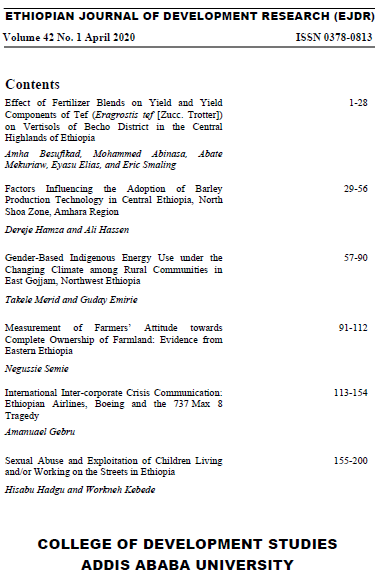Effect of Fertilizer Blends on Yield and Yield Components of Tef (Eragrostis tef [Zucc. Trotter]) on Vertisols of Becho District in the Central Highlands of Ethiopia
Keywords:
Blended fertilizers, Vertisol, Tef, CASCAPE, Becho, Central highlands, EthiopiaAbstract
After the nation-wide study of EthioSIS which discovered the deficiency of nutrients
such as Iron (Fe), Zinc (Zn), Boron (B), Sulphur (S) and Potassium (K), fertilizer
recommendation in Ethiopia switched to zinc, boron and the zinc-boron blends.
Nevertheless, there were no specifications for soil and crop types in this latest
fertilizer recommendation. To address this, Capacity Building for Scaling up of
Evidence-based Best Practices in Agricultural Production in Ethiopia (CASCAPE)
had been conducting farm trials on blend types and rates on various crops and soil
types in various parts of the country; among which tef in Vertisols is one of the trials
conducted in central highlands of Ethiopia. The trial was conducted in two cropping
seasons (2017 and 2018). In the first trial season, there were eight treatments (five
levels of NPSZnB, Di-ammonium Phosphate (DAP), NPS and QUEFTS) whereas in
the second, one treatment from the previous year (DAP) was dropped and two new
ones (NPSKB and NPSKZn) were added. The experimental layout was randomized
complete block with three replications. Soil sample, agronomic and economic data
were collected following standard procedures. In 2017, the yield benefit of the
different rates of NPSZnB blend did not significantly differ from that of 150 kgha-1
DAP and 100 kgha-1 NPS, which, in order of time, were the blanket recommendations
before the introduction of micronutrient containing fertilizer blends. In 2018, grain
yield for 300 NPSZnB kgha-1 was significantly higher than 100 NPS. Moreover, both
of the K-containing treatments, 300 NPKSB kgha-1 and 300 NPKSZn kgha-1 exhibited
higher yield than the maximum rate of NPSZnB. The combined over years analysis
revealed insignificant yield variation between most rates of NPSZnB, and only 300
NPSZnB kgha-1 was found to be significantly higher than 100 NPS kgha-1. In light of
Pearson correlation coefficients, there was a positive and significant correlation
between grain and straw yield with available P and Mn. In contrast, there was a
negative and significant correlation between grain and straw yield with K and OM.
However, the correlation of micronutrients Zn and B with grain and straw yield were
insignificant. The marginal rate of return (MRR%) of all the three high rates, 300
NPSZnB kgha-1, 300 NPSKB kgha-1 and 300 NPSKZn kgha-1, were above the
minimum acceptable rate of return (MARR) of 100%. Regardless of their actual nutrient composition, the insignificant but lower yield of the respective equivalent rates of the blend with NPS (100 kgha-1) and DAP (150 kgha-1) raises a question on
the worth of adding Zn and B at the expense of N and P. If and when their importance
in the formulation is conclusive, the current study suggests for the substantial raising
of the rate as only the maximum rate increased yield significantly. Considering the
addition of K and reducing N and P from NPS greater than the addition of B and Zn,
irrespective of how much to add, the highest yield by NPSKB and NPSKZn suggests
the merit of K in the blend.
Downloads
Published
How to Cite
Issue
Section
License
Copyright (c) 2022 Amha Besufkad, Mohammed Abinasa, Abate Mekuriaw, Eyasu Elias, Eric Smaling

This work is licensed under a Creative Commons Attribution 4.0 International License.


